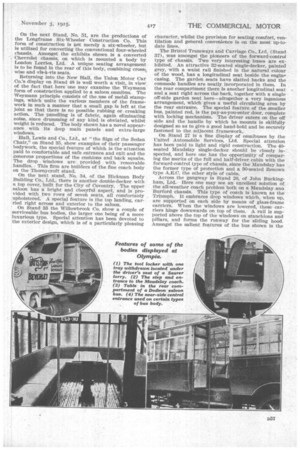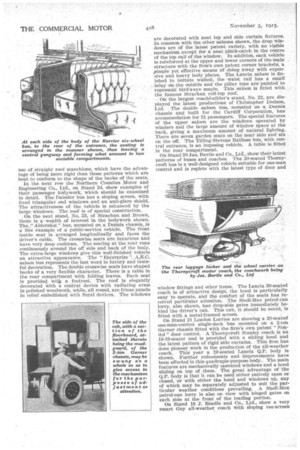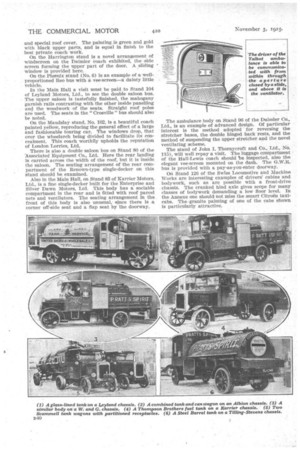SPECIAL FEATURES OF BODYWORK.
Page 42

Page 43

Page 44

Page 46

If you've noticed an error in this article please click here to report it so we can fix it.
Some Notes and Comments• on the Most Brilliant Display of Coachwork Ever Staged.
SUCH wonderful proeess has been made in the design and construction of passenger and commercial bodywork since the Shaw two years ago that the effect, at first, is almost startling; oven to the visitor who may have been able to anticipate the :general trend of the improvements made, as, for once in a while, one's anticipations are more than realized.
This year the passenger vehicle is decidedly in the ascendant. Several firms have designed new chassis with the low loading line now so much in demand. The buses and coaches mounted on these chassis, in the majority of instances, are not only luxuriously appointed, but each vehicle has a new aspect, and one has to get accustomed to a fresh set of proportions. There is evidence on every hand that efforts have been made to reproduce in detail the refinements of private• coachwork. Such an attempt is a courageous one, because everything is on a larger scale ; a more comfortable seat must be repeated a dozen or more times, the same conditions applying to any improved fitting introduced, whilst any special exterior finish or interior treatment has to be carried out over a comparatively large surface.
Perhaps the most interesting novelty shown this year . is the double-decker bus with a covered top. Examples
of these double saloon buses, all differing in detail, are to be seen on Stand 22 of Christopher Dodson, Ltd., Stand 34 of the Hickman Body Building Co., Ltd., and Stand 17 of Railless,Ltd:, in the New Hall, whilst, in the Main Hall, similar buSes are on view on Stand .104 of Leyland Motors, Ltd.; and Stand 80 of the Associated Equipment Co., Ltd. .
The modern coach is now, to all intents and purposes. a large open touring car. The height of the bonnet and body sides are on the same level.; the windscreen is often not only raked but. vee-shaped, a characteristic which . is also embodied in.. many of the buses shown.. The-hind emergencydoor of the front-entrance bus, with its quick-release fittings _accessible. either from. inside or outside,, will be seen to be now practically a standard fitting. Drop windows, mechanically operated, . are universally ,a.dopted.
The general finish of 'the bodywork is of a high order ; the, colour schemes 'Used, 'whether brilliant and attractive, or following a standard laid down,_or, on the other ., hand, chosen to give a taSfeftd and artistic effect reveal first7class workmanship. ' • n36
If one enters by the lIammersmith Road entrance into the New Hall and turns to the left, Stand 21 of Metcalfes (London), Ltd., is seen. Here is a delightful 20seated saloon bus, mounted on a low-loading Reo Pullman chassis painted cream, with the near side panelling rolled down and broken away so as to reveal the construction and interior luxury of the well-appointed armchair seats, roof decoration and parcel nets. A. vee-shaped screen is fitted and the whole is well designed.
On Stand 11 of Short Bros., Ltd., there is a 28-seater single-decker, mounted on an A.E.C. chassis, which has a novel rear entrance, in that the vehicle can be mounted either from the near or off side. The entrance is vestibuled and the inside of the.lower back panelling Is lined with aluminium 'sheeting. The upholstery is carried out in rattan, including the finish at the back of the seats. The end window on each side, which is of ample proportions, is removable so as to afford extra ventilation in fine weather. A smaller Dennis bus has a sociable compartment at the rear, the seating being arranged continuously round the hack and sides. This well-known firm are also the builders of the double saloon bus to be seen on the A.E.C. stand in the Main Hall. On Stand 1 of the Saurer Commercial Vehicle Co., Lid., there is an angle-iron lorry which is of special interest to those who use this form of construction. The lines of the driver's cab should also be noted. There is also an imposing 26-seated single-decker on this stand.
On the next stand, No. 2, of Harris and Hassell, Ltd., where the Reo chassis are shown, there is a smart coach body fitted with armchair seats. Those who have been perplexed as how to deal with the spare wheel without exceeding the 7-ft. 6-in, overall limit of width should note here how the difficulty has been surmounted. It is recessed Info the body side in a similar manner but to a less extent than the ordinary, wheelarches.
On Stand 17 of Railless, Ltd., in that portion, of Olympia which joins up the New and Main Halls, the first encounter with a double saloon bus is made. If the vehicle is approached from the front, one sees at a glance how symmetrical is the general appearance. The driving cabin is carried right across, and a feature of the seating in the lower deck is,The use of a seat faeing the rear carrie4 the full width of the body. 'Th,t1 accommodation is fok,i6 passengers in each saloon. On the next Stand, No. 51, are the productions of the Longframe Six-Wheeler Construction Co. This form of construction is not merely a six-wheeler, but is utilized for converting the conventional four-wheeled chassis. Amongst the exhibits shown is a converted Chevrolet chassis, on which is mounted a body by London Lorries, Ltd. A unique seating arrangement is to be found in the rear Of this body, combining crosswise and vis-à-vis seats.
Returning into the New Hall, the Union Motor Car Co.'s display on Stand 48 is well worth a visit,. in view of the fact that here one may examine the Weymann form of construction applied to a saloon omnibus. The Weymann principle consists of the use of metal stampings, which unite the various members of the framework in such a manner that a small gap is left at the joint so that there is no possible rubbing or creaking action. The panelling is of fabric, again eliminating noise, since drumming of any kind is obviated, whilst weight is reduced. The body shown has a novel appearance with its deep main panels and extra-large windows.
Hall, Lewis and Co., Ltd., at "the Sign of the Sedan Chair," on Stand 35, show examples of their passenger bodywork, the special feature of which is the attention paid to comfortable and safe entrance and exit and the generous proportions of the cushions and back squabs. The drop windows are provided with removable handles. This firm are builders of the fine coach body on the Thornycroft stand.
On the next stand, No. 34, of the Hickman Body Building Co., Ltd., there is another double-decker with a top cover, built for the City of Coventry. The upper saloon has a bright and cheerful aspect, and is provided with two rows of seveh seats, all comfortably upholstered. A special feature is the top landing, carried right across and exterior to the saloon.
On Stand 33 the Willowbrook Co. show a couple of serviceable bus bodies, the larger one being of a more luxurious type. Special attention has been devoted to the exterior design, which is of a particularly pleasing character, whilst the provision for seating comfort, ventilation and general convenience is on the most up-todate linos.
The Bristol Tramways and Carriage Co., Ltd. (Stand 37), was amongst the pioneers of the forward-control type of chassis. Two very interesting buses are exhibited. An attractive 32-seated single-decker, painted grey, with a waist rail finished in the natural colour of the wood, has a longitudinal seat beside the engine casing. The garden seats have slatted backs and the commode handles are neatly incorporated in them. In the rear compartment there is another longitudinal seat and a seat right across the back, together with a single off-side garden seat here—altogether a very ingenious arrangement, which gives a useful circulating area by the rear entrance. The special feature of the smaller bus, painted red, is the pay-as-you-enter door, complete with locking mechanism. The driver enters on the off side and the handle by which he mounts is skilfully designed so as to give a good hand-hold and be securely fastened to the adjacent framework.
On Stand 27 is a fine display of omnibuses by the United Automobile Services, Ltd. Special attention has been paid to light and rigid construction. The 40seated Maudslay single-decker should be closely inspected, and here one has the opportunity of comparing the merits of the full and half-driver cabin with the forward-control type of chassis, since the Maudslay has the former type of protection and a 30-seated Renown type A.E.C. the other style of cabin.
Across the gangway is Stand 26, of John Buckingham, Ltd. Here one may see an excellent solution of the all-weather coach problem both on a Maudslay ano Burford chassis. This type of coach is known as the Triumph. It embraces drop windows which, when up, are supported on each side by means of glass-frame carriers. When the windows are lowered, these carriers hinge downwards on top of them. A rail is supported above the top of the windows on stanchions and pillars, and forms the runway for the sliding hood. Amongst the salient features of the bus shown is the use of straight roof stanchions, which have the advantage of being more rigid than those patterns which are bent to conform to the shape of the backs of the seats.
In the next row the Northern Counties Motor and Engineering Co., Ltd., on Stand 24, show examples of their passenger bodywork, which should be examined in detail. The. Daimler bus has a sloping screen, with fixed triangular end windows, and an anti-glare shield. The attractiveness of the vehicle is enhanced by the large windows. The roof is of special construction.
• On the next stand, No. .23, of Strachan and Brown, there is a -wealth of interest in the bodywork shown. The," Aldershpt," bus; mounted on a Dennis chassis, is a fine example of a public-service vehicle. The front inside seat is arranged longitudinally and faces the driver's cabin. The crosswise seats are luxurious and have very deep cushions. The seating at the rear runs continuously around the off side and back of the body. The extra-large windows give this well-finished .vehicle an attractive appearane. The " Enterprise A,E.C. saloon bus represents the last word in luxury and tasteful decoration. The double crosswise seats have shaped backs of a very flexible character. There is a table in the rear compartment with folding leaves. Each seat is provided wit a footrest. The roof is elegantly decorated with a central device with radiating arms in polished woodwork, while, all round, are frieze panels in relief embellished with floral devices. , The windows are decorated with neat top and side curtain fixtures. In common with the other saloons shown, the drop windows are of the latest patent variety, with no visible mechanism_except for a neat pinch-catch in the centre of the top rail of the vvindow. In addition, each vehicle is reinforced at the upper and lower corners of the main structure with the firm's own patent corner brackets, a pimple yet effective means "a doing away with expensive and heavy body plates. The Lancia saloon is finished to imitate walnut, the waist rail has a small inlay en. the outSitle and the pillar tops arepainted to represent' bird's-eye maple. This saloon is fitted with the famousStrachan roll-top roof.
On the largest coachbuilder's stand, No. 22, are displayed the latest productions of Christopher Dodson, Ltd. The double saloon bus, -mounted. on a .Dennis chassis and built for the Cardiff Corporation, has accommodation for 51 passengers. The special features of the upper saloon are the windows operated by winders and the large amount of window space at the back, giving a maximum amount of natural lighting. There are seven garden seats on the near side and six on the off. The Tilling-StevenS Railless bus, with central entrance, is an imposing vehicle. A table is fitted in the rear compartment.
On Stand 20 Jas. 13artie and Co., Ltd., show their latest patterns of buses and coaches. The 20-seated Thornycroft bus is a well-designed vehicle suitable for one-man control and is replete with the latest type of door and window fittings and other items. The Lancia 30-seated coach is of attractive design, the hood is particularly easy to operate, and the comfort of the seats has received partieular attention. The Shell-111ex petrol-can lorry, also shown, has drop-side gates immediately behind the driver's cab. This cab, it should be noted, is fitted with a metal-framed screen.
On Stand 21 London Lorries are showing a 20-seated one-man-control single-deck bus mounted on a 2-ton Garner chassis fitted with the firm's own patent " Nondol " door control. A Thornycroft Stanley coach is an 18-19-seater and is provided with a sliding hood and the latest pattern of rigid side curtains. This firm has done pioneer work in the production of the all-weather coach. This year a 19-seated Lancia Q.P. body is shown. Further refinements and improvements 'have been effected in this quadruple-purpose body. The main features are mechanically operated windows and a hood sliding on top of them. The great advantage of the Q.P. body is that it can be used either entirely open or closed, or with either the hood and Windows up, any of which may be separately adjusted to suit the particular weather conditions prevailing. A Shell-Mex petrol-can lorry is also on view with hinged gates on each side at the front of the loading portion.
On Stand 18 J. Beadle and Co., Ltd., show a very smart Guy all-weather coach with sloping vee-screen
and special roof cover. The painting is green and gold with black upper parts, and is equal in finish to the best private coach work.
On the Harrington stand is a novel arrangement of windscreen on the Daimler coach exhibited, the side screen forming the upper part of the door. A sliding window is provided here.
On the Phcenix stand (No. 6) is an example of a wellproportioned Reo bus with a vee-screen—a dainty little vehicle.
In the Main Hall a visit must be paid to Stand 104 of Leyland Motors, Ltd., to see the double saloon bus. The upper saloon is tastefully finished, the mahogany garnish rails contrasting with the other inside panelling and the woodwork of the seats. Straight roof poles are used. The seats in the " Crosville " bus should also be noted.
On the Maudslay stand, No. 102, is a beautiful coach painted yellow, reproducing the general effect of a large and fashionable touring car. The windows drop, that over the wheelarch being divided to facilitate its concealment. This coach worthily upholds the reputation of London Lorries, Ltd.
There is also a double saloon bus on Stand 80 of the Associated Equipment Co., Ltd. Here the rear landing Is carried across the width of the roof, but it is inside the saloon. The seating arrangement of the rear compartment of the Renown-type single-decker on this stand should be examined.
Also in the Main Hall, on Stand 88 of Karrier Motors, Ltd., is a fine single-decker built for the Enterprise and Silver Dawn Motors, Ltd. This body has a sociable compartment in the rear and is fitted with roof parcel nets and ventilators. The seating arrangement in the front of this body is also unusual, since there is a corner off-side seat and a flap seat by the doorway.
The ambulance body on Stand 96 of the Daimler Co., Ltd., is an example of advanced design. Of particular interest is the method adopted ' for reversing the stretcher bases, the double hinged back rests, and the method of suspending the upper stretcher and the novel ventilating scheme.
The stand of John I. Thornycroft and Co., Ltd., No. 115), will well repay a visit. The luggage compartment of the Hall-Lewis coach should 'be inspected, also the elegant vee-screen mounted on the dash. The G.W.R. bus is provided with a pay-as-you-enter doorway.
On Stand 126 of the Swiss Locomotive and Machine Works are interesting examples of drivers' cabins and bodywork, such as are possible with a front-drive chassis. The cranked hind axle gives scope for many classes of bodywork demanding a low floor level. In the Annexe one should not miss the smart Citron taxicabs. The•granite painting of one of the cabs shown is particularly attractive.
















































































